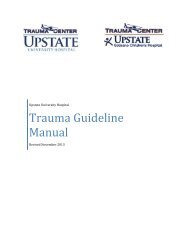10 Alumni Journal - SUNY Upstate Medical University
10 Alumni Journal - SUNY Upstate Medical University
10 Alumni Journal - SUNY Upstate Medical University
Create successful ePaper yourself
Turn your PDF publications into a flip-book with our unique Google optimized e-Paper software.
Tales from the front<br />
robert Dracker, MD ’82, may be back in<br />
Syracuse, but every night, in his dreams,<br />
his thoughts return to Haiti. “It’s like I’m still on<br />
rounds and I still have things to do,” he says.<br />
“I keep seeing the children’s faces and their<br />
smiles and injuries.” And he continues to smell<br />
the country’s distinct odor—a unique mixture<br />
of “burning mahogany, vanilla, spice, and<br />
brown dirt,” he says.<br />
Dr. Dracker, a Syracuse pediatrician and<br />
hematologist/oncologist spent the second<br />
week in February at Sacré Coeur, a hospital<br />
75 miles north of Port-au-Prince, which has<br />
become an epicenter for victims of January’s<br />
devastating earthquake.<br />
In his role as president of the Onondaga<br />
County <strong>Medical</strong> Society, Dracker solicited the<br />
greater-Syracuse medical community in the<br />
immediate aftermath of the Haiti earthquake<br />
to encourage physicians to assist in whatever<br />
way they were able. He was contacted by<br />
gastroenterologist Michael Fitzgerald, MD,<br />
who told him about his involvement with<br />
CRUDEM, a foundation that helps support<br />
Hópital Sacré Coeur in Cap Heitien, which<br />
was receiving the sick and injured from Port<br />
au Prince.<br />
Just a couple weeks later, Dracker traveled<br />
to Haiti with Dr. Fitzgerald and a small group<br />
of other medical professionals. They were<br />
among approximately <strong>10</strong>0 medical volunteers<br />
(physicians, nurses, and dentists) working at<br />
the facility that week from around the globe.<br />
While the initial medical need in Haiti<br />
had been surgical/trauma, by the time<br />
Dracker arrived, the focus was more medical<br />
in nature—treating infections and managing<br />
wounds and amputations. “I had absolutely no<br />
idea what to expect,” says Dracker of his first<br />
glimpse of his patients.<br />
The hospital housed more than 300 adult<br />
patients in tents and 50-60 children in a pediatric<br />
unit.<br />
“Two-thirds of the children had undergone<br />
amputations—arms or legs or both. They were<br />
s t u d e n t r o u n d s<br />
A week in haiti gave robert dracker, md ’82, a new perspective on<br />
medicine and public health policy.<br />
Top: Bob Dracker, MD ’82, treats a patient for<br />
injuries suffered in the Haiti earthquake.<br />
Right: A young patient recovers from an<br />
amputation.<br />
all scattered along the dirty floor on sheets<br />
and mattresses. It was always very noisy,” he<br />
says. “At first it was overwhelming, but we just<br />
dove in and started to provide the care that<br />
was necessary.”<br />
Each day began with a review of the daily<br />
medications with the nursing staff, followed<br />
by examinations of each patient. “We might<br />
examine a wound, or change dressings on<br />
amputation sites,” he says. “Unfortunately,<br />
there was always a lot of pain management<br />
necessary for the wound care of the physical<br />
therapy we made the children perform.”<br />
On top of their injuries from the earthquake,<br />
Dracker said the children were uniformly<br />
protein calorie malnourished and vitamin and<br />
iron deficient, and many had intestinal parasites<br />
A l U M n i J o U r n A l / s P r i n g 2 0 1 0 17

















